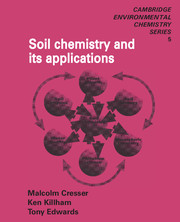4 - Soil chemical reactions
Published online by Cambridge University Press: 05 August 2012
Summary
Having considered at some length in Chapters 2 and 3 the nature and origins of both the inorganic and organic components of soil, we are now in a position to consider how these components interact with water to regulate the chemical composition of the soil solution. These chemical and physicochemical interactions govern the chemical composition of the plant root environment, and hence short-term nutrient availability to plants. They also regulate drainage water chemistry, and are therefore clearly of great importance. It is appropriate to begin by looking more closely at the cation exchange behaviour of soils.
Cation-exchange properties of soil clays
The existence of cation-exchange properties of smectites and vermiculite has already been mentioned in Chapter 2. So far, however, we have only considered cation exchange from negatively charged sites arising as a consequence of isomorphous substitution by cations of similar size but with lower charge, occurring in interlayer spacings. Generally the cations in the interlayer spacings are only labile when the spacing is ca 1.4 nm or more. In addition to negative charge arising as a result of isomorphous substitution, it also occurs at the edges of crystals where valences would otherwise be incompletely satisfied. The individual clay particles in a moist soil will thus be surrounded by a layer of hydrated, positively charged cations. This, in turn, creates a localised zone of positive charge, which will attract anions from the soil solution, creating an electrical double layer.
- Type
- Chapter
- Information
- Soil Chemistry and its Applications , pp. 58 - 99Publisher: Cambridge University PressPrint publication year: 1993



